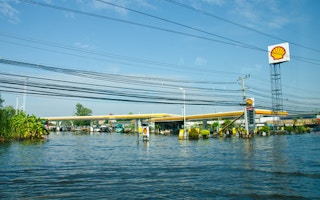BONN – A groundbreaking study published last November revealed that the activities of a mere 90 producers of coal, oil and gas, and cement – dubbed the “carbon majors” – have led to 63 per cent of all CO2 emissions since the Industrial Revolution.
To continue reading, subscribe to Eco‑Business.
There's something for everyone. We offer a range of subscription plans.
- Access our stories and receive our Insights Weekly newsletter with the free EB Member plan.
- Unlock unlimited access to our content and archive with EB Circle.
- Publish your content with EB Premium.
The report was released just weeks after Typhoon Haiyan (or Yolanda as it was known locally) tore through the Tacloban region in the Philippines. With unprecedented wind speeds of 315 kilometers (196 miles) per hour, the storm killed 6,300 people, left four million homeless, and caused more than $2 billion of damage.
Haiyan and its devastation became a rallying cry for delegates at the subsequent United Nations climate-change conference in Warsaw. In response, they agreed to establish an international mechanism to address climate-change-related “loss and damage,” to be applied in countries that are unable to adapt or protect themselves from the worst effects of global warming.
Those most vulnerable to climate change are often least responsible for its causes, and have the fewest resources to deal with its consequences. Contrast this with the carbon majors, which have made huge fortunes from the fossil fuels that are largely responsible for climate change. In 2013, the combined profits of just four majors – Chevron, ExxonMobil, BP, and Shell – topped $94 billion. This colossal return was possible only because these companies externalize their products’ highest cost – the climate devastation borne by the poor and vulnerable.
“
In 2013, the combined profits of just four majors – Chevron, ExxonMobil, BP, and Shell – topped $94 billion. This colossal return was possible only because these companies externalize their products’ highest cost – the climate devastation borne by the poor and vulnerable
It seems only fair and reasonable, therefore, that all fossil-fuel entities, but especially the carbon majors, pay a levy on each ton of coal, barrel of oil, or cubic meter of gas they produce to a new International Mechanism for Loss and Damage, which would help to fund efforts to address the worst effects of climate change. Furthermore, given that the effects of climate change today are the result of past emissions, the carbon majors should pay a historical levy, too.
If set initially at a relatively low $2 per ton of carbon, these levies could raise $50 billion annually, though the rate should increase each year. The revenues could support vulnerable countries’ efforts to develop long term plans to deal with climate change, as well as finance pilot projects aimed at minimizing loss and damage, sharing information, and replicating best practices. They could fund the monitoring and forecasting of slow-onset and extreme-weather events, enabling authorities and the public to prepare more effectively for an impending disaster. And the money could cover loss-and-damage risk premiums on individual, local, national, regional, or international insurance policies.
Governments would collect the levies from the carbon majors, perhaps when they collect royalties and other extraction-related fees, and deposit the money with the international mechanism. If the new levy were added to existing fees, it would strengthen the price signal driving a shift away from fossil fuels and toward renewables.
This fossil-fuel levy would be entirely compatible with the norms established by the United Nations Framework Convention on Climate Change and with the “polluter pays” and “do no harm” principles of international law, according to which organizations are required to pay for the damage that they cause. Indeed, the arrangement would be similar to existing regimes, such as those covering oil-spill compensation or nuclear damage.
But paying the cost of one’s damage, though necessary, is far from sufficient. After all, a compensation levy should not imply that the carbon majors have effectively bought a right to pollute. We must also work to stop inflicting harm on the most vulnerable people (and on ourselves). When the world’s governments meet at the UN climate-change conference in Paris in 2015, they must agree on ways to phase out net greenhouse-gas emissions and stop burning fossil fuels by mid-century. According to Carbon Tracker, 80 per cent of fossil-fuel reserves must remain in the ground if we are to avoid catastrophic climate change.
Even at today’s “low” level of climate change, the devastation is already all too real. It is real for the Philippines citizens mourning relatives and trying to rebuild homes and lives; for the Pacific Islanders growing crops in containers, importing drinking water, and building sea walls to protect their islands from the encroaching ocean; and for hungry farmers in the Sahel. And it is a growing reality for millions of other vulnerable people worldwide.
These people deserve the world’s support – not just moral support, but genuine help in the form of effective, properly funded mechanisms designed to prevent, or at least alleviate, the climate-related hardships inflicted upon them by past and present industrialization. For the carbon majors, the time to pay up has arrived.
Naderev (Yeb) Saño is a commissioner with the Philippines Climate Change Commission. Julie-Anne Richards is Manager of International Policy for the Australia-based Climate Justice Program and co-authored the report Carbon Majors Funding Loss and Damage. © Project Syndicate 1995–2014










